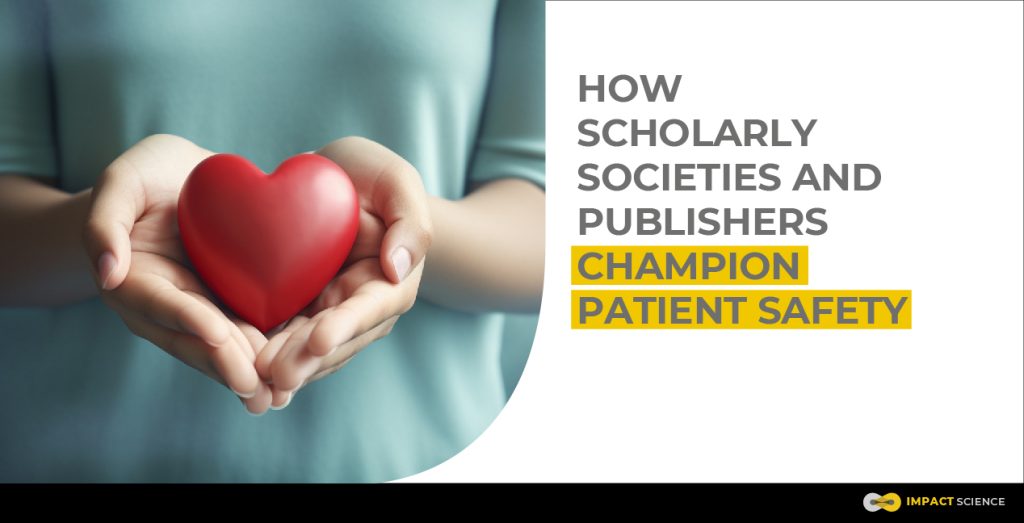Patient safety focuses on preventing, reducing, and analyzing errors and avoidable harms. Given that poor patient care is among the ten leading causes of death and disability worldwide, WHO considers patient safety a global concern.
By curating the scientific literature and ensuring its quality, academic publishers have a central role in advancing the scientific frontier. Similarly, research societies support the development and dissemination of knowledge in various disciplines. They publish journals, develop professional excellence, raise public awareness, and recognize and award significant achievements. Together, publishers and scholarly societies help define and set standards for their professional fields and promote high standards of quality. In clinical research, these standards also include aspects of ethics, privacy, and mental and physical well-being of patients. Safety is needed for patients involved in clinical trials, as well as for the secondary use of data and biological samples. Further, publishers and societies need to consider benefits and risks to individuals and the public.
Let’s look at how research societies and publishers contribute to patient safety through various practices.
1. Curating and disseminating reliable research
Scholarly publishers and societies are established channels for disseminating medical knowledge through their journals, conference proceedings, and various fora. These publications pass through mandatory peer review, academia’s quality control process. We frequently hear how peer reviewers are “gatekeepers,” in that they judge the novelty and importance of studies. But peer review also helps in identifying potential risks and flaws in research methodologies that could impact patient safety. Peer review must ensure strict scrutiny to uphold current laws and guidelines around ethically sound human research.
Remember how non-peer-reviewed preprints and rushed peer review during the COVID-19 pandemic caused potentially misleading information to spread? Swift retractions of spurious COVID-19 literature in both preprints and peer-reviewed papers, including those from high-ranking journals, served to prevent public health risk by curtailing the release of information that could harm patient safety. Thus, journals and societies must maintain responsible research practices during global emergencies.
Further, peer reviewers should be alert to overt unethical research practices like ethics dumping. In a classic case of ethics dumping, in clinical trials conducted in India from 1998 to 2015, thousands of women were placed in a control group without access to proper cervical cancer screening, despite effective methods being available. These women were thus knowingly exposed to the risk of developing and dying from cervical cancer. Research with poor ethical standards should raise red flags in pre-registration, grant review, and peer review stages to prevent the exploitation of vulnerable populations and protect the rights of research participants.
2. Making research advances accessible and understandable
Research is rapidly becoming more complex and interdisciplinary, and efficient sharing of information between researchers and the public has become more important now than ever before. Open Science calls for collaboration between diverse knowledge systems and highlights the importance of “open engagement” and participatory research. Involving patients in research can enhance the quality of healthcare provided and foster mutual learning, as patients gain a deeper understanding of fundamental scientific research, while researchers broaden their perspectives to better appreciate what matters most to patients. Patient partners can also help disseminate research findings, facilitating communication with the public and enhancing trust in the clinical research community.
Open access (OA) is one of the elements of Open Science. To be truly successful, advances in medicine must be accessible and understandable to patients across demographics. Moreover, OA publishing increases the accessibility of patient safety–related research to a wider audience. Numerous journals in the field of patient safety follow some form of OA, e.g., Patient Safety in Surgery and Journal of Patient Safety. In fact, the Journal of Patient-Centered Research and Reviews (JPCRR) is a Diamond OA journal, which means permanent and free access to published scientific works for readers and no publication fees for the authors.
3. Educating and training healthcare professionals about patient safety
Professional societies are well positioned to provide educational resources and training to researchers regarding ethical considerations and patient safety. As early as 1984, the American Society of Anesthesiologists established the Anesthesia Patient Safety Foundation (APSF). The APSF champions anesthesia patient safety and aims to improve the safety of patients during anesthesia care by identifying safety initiatives and creating relevant recommendations. The American Society of Clinical Oncology and the American Heart Association provide online resources to help patients obtain information about research relevant to their health concerns. Societies such as the Professional Society for Health Economics and Outcomes Research routinely organize workshops, seminars, and short courses focusing on patient safety issues.
4. Transparent reporting of errors, adverse events, and negative findings
Journals and societies are bringing about initiatives to promote transparency in reporting negative outcomes. For example, after noting the deficiencies in the reporting of adverse events in manuscripts submitted to the Canadian Journal of Anesthesia, the journal declared its commitment to accurate and transparent scientific reporting, endorsing “CONsolidated Standards of Reporting Trials” (CONSORT). Now, most journals encourage authors to follow “Enhancing the QUAlity and Transparency Of health Research” (EQUATOR) reporting guidelines. However, a recent study showed that the CONSORT checklist is not adhered to in a large number of published trials, underscoring the role journals can play by mandating critical reporting practices.
Besides reporting the effectiveness of therapeutic interventions against associated risks, it is crucial to broaden the scope of reporting to include near misses or close calls. Research societies and publishers are also encouraging the publication of negative results and failed clinical trials to prevent the duplication of studies on potentially harmful treatments or interventions.
5. Meaningful collaborations for developing safety regulations
By working alongside regulatory agencies and collaborating with healthcare professionals, scholarly societies and publishers can help develop and implement research-based safety regulations. They can facilitate communication between researchers and clinicians to ensure that research findings are translated into safer medical practices. Working closely with patient advocates can be immensely beneficial too. The American Society of Clinical Oncology (ASCO) includes patient representatives on the ASCO Cancer Research Committee and ASCO Expert Panels for their inputs on developing guidelines, and the American Association for Cancer Research fosters connections between patient advocates and researchers. Patient advocates can guide researchers on making studies more patient-centric, e.g., regarding the frequency of biopsies or treatment logistics. Such feedback is instrumental in designing studies with a better focus on patient satisfaction and safety.
Closing thoughts
Scholarly publishers and societies have a moral imperative to uphold patient safety in medical research and practice. They can contribute to this by establishing and inculcating ethical standards for research involving human subjects; fostering openness and knowledge-sharing among researchers to ensure safer medical practices; and collaborating with researchers, healthcare professionals, and patient advocates.
Collective and evolving efforts by publishers and societies can drive healthcare policies and safety measures to meet patients’ needs and preferences, while building and maintaining support, trust, and transparency.









